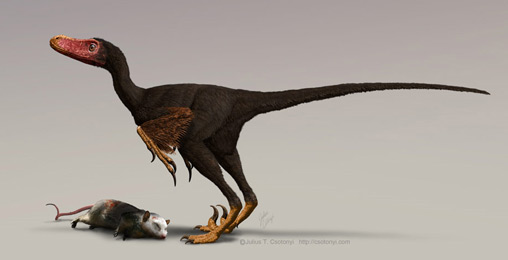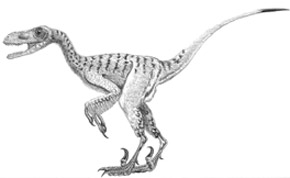Sniffing out the Origin of Birds
A new study published in the scientific journal, the Proceedings of the Royal Society B (Biology) shows that the sense of smell of small theropod dinosaurs may have improved over time and this would have had important implications for their evolutionary descendants – the birds.
Although having a good sense of smell is only part of the story, some scientists have speculated that the ancestors of modern birds might have survived the end Cretaceous extinction event that wiped out the theropods and all other Dinosauria for that matter, by having a better sense of smell.
The Origin of Birds
Prior to this new study, a view held by a number of scientists was that as birds evolved from small, cursorial theropods, their olfactory sense (smell) became less prominent at the expense of the need to evolve better vision, better balance and improved co-ordination for active flight.
Commenting on the study, researcher, Darla Zelenitsky, a palaeontologist with the University of Calgary (Alberta, Canada) stated:
“Scientists thought that parts of the brain were being dedicated to these latter senses, while the region of the brain associated with olfaction deteriorated through evolution.”
However, by examining the braincases and skull proportions of species, an estimate of the brain size can be deduced and from this information, with a little further work, the size of the region of the brain dedicated to smell can be calculated. In humans, the olfactory bulb, that portion of our brains dedicated to analysing smells, is very small, making up a tiny proportion of our overall brain mass. In dogs, an animal known for its keen sense of smell, the olfactory bulb is many times larger than our own and it makes up a much larger proportion of the dogs overall brain mass.
In the famous theropod Tyrannosaurus rex, nearly 50% of its brain mass is dedicated to the sense of smell, this proportion of brain mass/smelling sense is only exceeded by the extant Turkey Vulture, (Cathartes aura) which relies on its remarkable sense of smell to detect rotting meat hidden under the canopy of jungle trees.
The research team examined the skulls of a number of extinct and extant creatures including the skull material associated with the first bird known to science (Archaeopteryx lithographica). The team discovered that this Jurassic bird/reptile probably had as good a sense of smell as its dinosaur relatives.
Small Theropods such as Bambiraptor Had a Good Sense of Smell

Picture credit: Julius Csotonyi
The illustration shows a typical dromaeosaur (Bambiraptor), a fast running, cursorial predator. Skull analysis suggests these little dinosaurs had an acute sense of smell.
A lot of work has been done on Archaeopteryx by scientists at the Natural History Museum, working closely on the “London specimen”. The aim of this research led by the distinguished Dr Angela Milner was to determine this ancient creature’s flight capabilities and in particular examine evidence for its sense of balance and hearing.
To read more about this research: Lets Hear It for Archaeopteryx.
To see how the sense of smell might have changed as birds evolved, researchers studied 130 species of living birds, seven species of fossil birds and 20 species of nonavian Theropod dinosaurs, which include carnivores such as Velociraptors and the mighty Tyrannosaurus rex. The team concentrated on the dimensions of the animals’ olfactory bulbs, measuring them and working on the assumption that “larger bulbs meant a better developed sense of smell”.
The researchers found the sense of smell improved overall during the evolution of small theropods to modern birds, apparently only decreasing much later on in some lineages of birds less dependent on scent. The earliest bird-like creatures such as Archaeopteryx, had a sense of smell comparable to pigeons, while some dromaeosaurs had a sense of smell perhaps as acute of that of the Turkey Vulture.
A Sense of Smell as Good as a Turkey Vultures?

Picture credit: Everything Dinosaur
This improved sense of smell, as well as larger brains overall, might have provided an edge that could explain why modern birds are still around and their dinosaur and archaic bird relatives are not.
For replicas and models of dromaeosaurid dinosaurs: Beasts of the Mesozoic Dinosaur Models.
Darla Zelenitsky added:
“Since some modern-day birds are known to use their sense of smell for foraging and for navigation, perhaps the combination of flight and larger brains — including larger olfactory bulbs — gave modern birds a competitive edge over archaic birds and other dinosaurs to survive this mass extinction.”






Leave A Comment